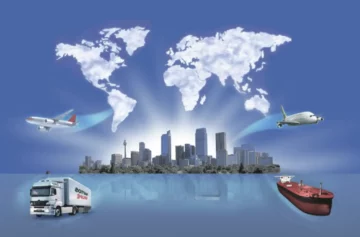
When I was COO, IT/software engineering commonly reached out with requests like: “We’re running low on capacity and need another blade!” To which I’d think: “There’s goes another $400,000.” Like so many others, we had to continuously buy capacity to handle our growing peak periods – end of month, end of quarter, end of year, thousands upon thousands of concurrent sessions, seasonal fluctuations (like today’s BFCM).
As supply chain software evolved and businesses increasingly outsourced solutions, total cost of ownership shifted, alleviating not only the cost of hardware, software, and departmental headcount, but also some of the sunk costs already embedded in the enterprise, like the facilities, networks, security, administration, shared services, and so on. And yet, the accrual of systems and outsourced solutions found their own complexities and cost inefficiencies.
As supply chain software continues to evolve, so do the possibilities for running an efficient digital, global supply chain – especially one that simplifies how the IT landscape is managed at the lowest total cost of ownership.
Shifting the Burden from On-Site to SaaS
If you examine a typical company’s IT platform, you’ll likely find an ERP, possibly a separate accounting system, mail and file shares, web hosting, and some point solutions bolted on to augment the ERP – inventory and warehouse management, shop floor controls, production reporting systems, transportation management, and so on.

Companies got smarter by shifting from a CapEx approach to an OpEx approach. Theydownsized departments by outsourcing to big firms with large managed service facilities in India. It worked – kind of. In my experience, costs dropped, but so did responsiveness and service levels, and customizations took longer.
When Software-as-a-Service gained popularity, companies could shift almost all costs to a variable model, instead of a mix of localized fixed costs and remote variable. Organizations retained and owned their own data, while nearly everything else – from software, servers, facilities, data centers to networks, security, configuration and administration – became subscription-based and the provider’s responsibility.
Multiple Systems, Multiple Instances Problem
As more companies went digital and turned to the cloud, the new total cost of ownership reckoning revolved around having multiple SaaS setups, systems, and instances. Most companies that I worked for had a different instance of their “system of record” software per region – the Americas, EMEA, APAC, BRICS, ROW – which made it difficult to easily follow their customers in the way they needed. Ironically, large companies often ended up with a global control tower they couldn’t use globally, accepting multiple instances as status quo and taking for granted that language and culture barriers necessitated it.
And these are just examples of single solutions. Disjointed systems across Order Management Systems (OMS), Control Towers, Transportation Management Systems, Returns Management Systems, etc., also complicate operations from a time and cost perspective. An upgrade in one area leads to extra implementations and costs in other areas, and complex systems landscapes require upkeep across various maintenance schedules and coordination across multiple providers. For companies operating separate business units, it’s also common to accrue systems and process silos that are custom fit to each business unit’s specifications.
 According to the State of SaaS Ops report, the proliferation of SaaS apps in companies has further resulted in the inadvertent use of multiple apps that solve the same use case. Data resides in multiple disparate and siloed apps, and cost isn’t properly optimized.
According to the State of SaaS Ops report, the proliferation of SaaS apps in companies has further resulted in the inadvertent use of multiple apps that solve the same use case. Data resides in multiple disparate and siloed apps, and cost isn’t properly optimized.
The reality is multiple instances and disjointed systems are an unnecessary burden, as business processes are the same wherever you go. Managing the flow is where there is often variability; how do you enter an order? How many steps are involved and, if you operate across multiple sales channels, do you have different ways of receiving an order and delivering it? It’s common for organizations to process these steps differently depending on where each business unit is located; the North American branch may be on the latest and greatest version, while the European branch is still operating on a down-level version of the same system. Companies also customize processes, and those that grow by acquisition often keep their acquired companies’ IT systems instead of integrating to a common standard. But today’s technology allows businesses to simplify their technology strategy and unify people, systems, and processes.
It’s Time for Simplification: Single Instance, & Lowest Total Cost of Ownership
As a supplier to many of the world’s largest tech companies, we were anxious to grow along with our customers as they expanded globally. What that meant, though, was to operate the same way on the same systems everywhere, and to eliminate “shadow IT.” When I had the chance as a leader, I decided to install a single instance worldwide. After implementation, it was also extremely cost effective and flexible.
 Case in point – I acquired a same-size global competitor; they had separate instances and customizations of their IT platform by region and a supporting headcount of over 200 people. I had a worldwide single instance and supporting headcount of 30+. The pain (as in one-time cost) came from converting their multiple systems to one.
Case in point – I acquired a same-size global competitor; they had separate instances and customizations of their IT platform by region and a supporting headcount of over 200 people. I had a worldwide single instance and supporting headcount of 30+. The pain (as in one-time cost) came from converting their multiple systems to one.
If you’ve built your business on the backs of multiple systems and acquisitions, all is not lost. Simplification is not about boiling the ocean; it’s about doing the hard work of putting everything on the same platform. Lowest total cost of ownership in the modern era comes from implementing a platform that is multi-capable and future proof. A technology that offers a range of solutions on a single-view platform, ideally natively unified to avoid middleware and the hassle of logging in and out between systems. Holistic supply chain software also offers the quickest time to value for your digital transformation. Rather than spending on a new system every time business growth demands new processes, think strategically today and opt for a platform that is flexible and configurable enough to scale as your business evolves. No one knows what their future holds – but in my experience, the best supply chain software is the one that won’t hold you back.
See the solution in action by downloading a case story. Learn how DSV embraced the complexity of its global business units, as well as the specific and time-sensitive needs of their new FMCG client using a single-instance control tower with a global footprint. To learn more about how the MPO Supply Chain Control Tower can similarly enable to optimize operations against service and cost, contact our team at info@mpo.com or request a demo today.
- Bitcoin
- blockchain
- blockchain compliance
- blockchain conference
- Business Advice
- coinbase
- coingenius
- Consensus
- Cost Management
- crypto conference
- crypto mining
- cryptocurrency
- decentralized
- DeFi
- Digital Assets
- Digital Transformation
- ethereum
- machine learning
- MPO Blog
- non fungible token
- plato
- plato ai
- Plato Data Intelligence
- Platoblockchain
- PlatoData
- platogaming
- Polygon
- proof of stake
- Quick-Time-to-Value
- Supply Chain Complexity
- W3
- zephyrnet













